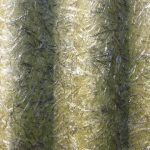Felt made from natural fibers, such as wool felt, is biodegradable.
By contrast, felt made from synthetic materials like acrylic is not biodegradable, so it’s important to know what type of felt you’re working with.
In the rest of the article, we are going to learn how to use felt in an environmentally conscious way.
Is Felt Environmentally Friendly?
Broadly speaking, the answer to this depends on the type of felt.
Natural Felt
Natural felt, commonly made from wool, ticks many boxes that allow it to wear its “environmentally friendly” crown with pride:
- Wool felt is completely biodegradable unless heavily treated with chemicals.
- Since sheep grow a new fleece every year, it’s a totally renewable resource.
- When done properly, shearing does not harm sheep and is even beneficial.
Synthetic Felt
On the other hand, synthetic felt, typically made from nylon, acrylic, or recycled plastic, is not so environmentally friendly due to the following:
- It’s not biodegradable.
- Like many other man-made products, creating synthetic felt necessitates the use of fossil fuels such as petroleum. This means that it’s not a renewable resource, and the extraction of the petroleum itself can damage the environment.
Of course, synthetic felt created from recycled plastic could be said to be one step above other types of synthetic felt in the eco-friendly stakes; however, if you’re particularly environmentally conscious, natural felt might be the better option.
Is Felt Recyclable?
Thrown away clothing and textiles take up 5% of landfill space, with each American throwing away 70 lbs per year on average, according to RecycleNation.
This is why it is essential to recycle your felt, and it can be done in different ways.
Re-purposing
You can give your felt items new life by using them for a different purpose when you no longer need them for their original one.
Turn that worn out fancy piece of clothing into work clothing so you have something durable and high-quality to wear without worrying about it getting ruined.
Another option is turning felt clothing into bags or cleaning supplies instead of going out and buying new products that you don’t really need.
You can even let your creative side through and re-purpose your old felt for arts and crafts material. From more practical things like Christmas tree skirts to more decorative ones like cut-out shapes to glue to cards, you can always find some use for your felt if you think outside the box.
Donating
You might no longer need your felt item, but that doesn’t mean that no one else does.
The most efficient way to recycle something is often to give it to someone else who needs it.
Your felt items can find their new home at a Salvation Army store or other local charity, and with no waste generated in the process.
Recycling Centers
If you’re having a hard time deciding what to do, let the professionals handle it.
Many recycling centers are already equipped to handle felt products. A lot of what can be re-purposed as secondhand clothing will be sent to third world countries.
Most of the rest gets shredded to be recycled into new products instead of taking up space in landfills.
Is Felt Sustainable?
Once again, the answer to this comes down to which type of felt you’re referring to.
Natural felt is a great example of a sustainable material as sheep continually produce wool, and in doing so they cause no harm to the environment and no depletion of natural resources.
Synthetic felt, however, is unsustainable. Extracting the petroleum needed to create synthetic felt can lead to a number of ecological disasters, and petroleum itself is predicted to run out by 2052.
Of course, it could be argued that synthetic felt made from recycled plastic is more sustainable than its non-recycled counterpart; after all, of all the shortages plaguing our planet, plastic waste is not one of them.
The problem is that its production is still predicated on pre-existing plastic products which are unsustainable in and of themselves.
Another element to this discussion is the human cost of felt production. Whether we’re talking natural or synthetic, artisanally made felt is obviously more sustainable than material produced in a sweatshop.
Summary
We’ve learned that it’s important to look at whether your felt is natural or synthetic to determine environmental impact as only natural felt is biodegradable.
More importantly, you now know that there are many ways to ensure you’re using your felt in a way that is clean and safe for the environment, even if it’s synthetic.
You can re-purpose your old felt to give it new life, you can donate it to others in need, or you can pass it along to a recycling center which will find the best way to not send it to a landfill, whether that means exporting it or shredding it down for new products.
Whichever route you take, you’ll know you’re using your felt responsibly.

